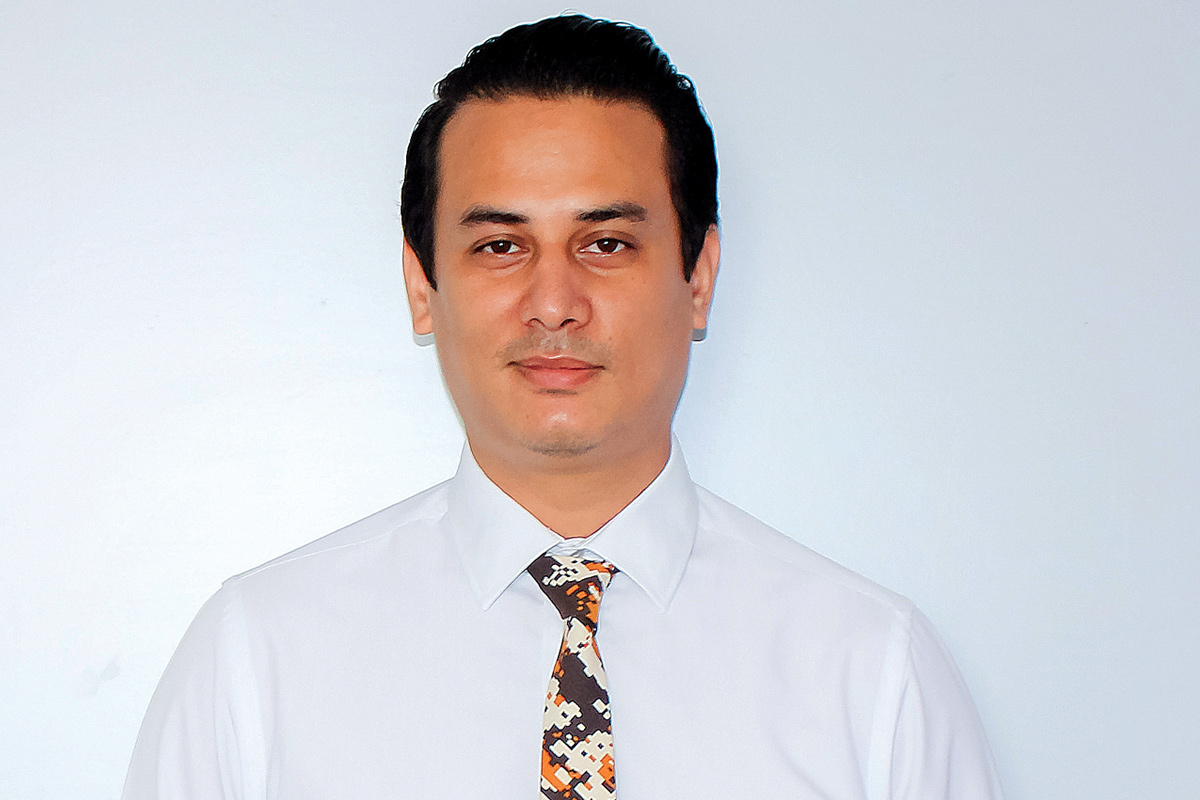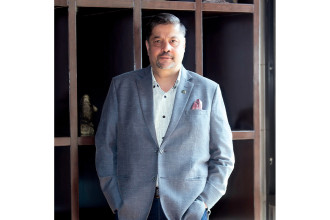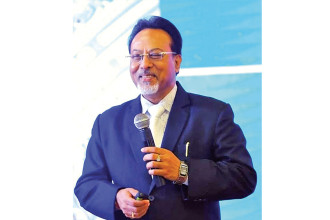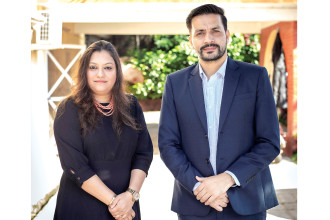
Born in Biratnagar and schooled in Kalimpong, Dr. Nikesh Rajbhandari is a MD Psychiatrist who is currently based in Biratnagar. Rajbhandari who completed his MBBS from Kathmandu Medical College and his MD is Psychiatry from BP Koirala Institute of Health Sciences in Dharan, shares that he truly dived into the world of medical psychiatry during an internship as an MBBS student.
Today Dr. Rajbhandari who has been practicing since 2015 is associated with the Koshi Hospital, Morang Sahakari Hospital and Manav Sewa Ashram, the latter in which he serves pro bono.
Dr. Rajbhandari also works with the Nileshmani Rajbhandari Foundation, an NGO that he initiated in memory of his late brother. Dr. Rajbhandari through the foundation recently organised a free mental health tele-consultation for people seeking help regarding mental health issues during the pandemic.
Dr. Rajbhandari talks to B360 about how mental health is perceived across Nepal, what the situation is like for mental health practitioners here, and how the Covid 19 has affected the mental health situation in the country in an interview with Sajeet Rajbhandari.
How do perceive mental health literacy in Nepal? What sort of stigmas and prejudices do we need to overcome?
I do free consultations for an organisation called Manav Sewa that helps homeless people and works to rehabilitate them. About a month ago, the team went to Udayapur and found a group of homeless people and brought them in for rehabilitation. Amongst the group was a middle-aged man, probably over 35. What was very disheartening and surprising was that the man had been kept in a cage for about 13 to 16 years because he was not mentally sound. Since I haven’t been able to visit them right now because of the current situation, I get updates from the staff who tell me that he had been conditioned into behaving like an animal. The reason I share this story is that even though it’s the year 2020 and there has been so much advancement in medical science and technology, stories like this are still very much prevalent in Nepal. While severe cases like these are not very common, it is important to note that these things still happen and literacy about mental health is still quite low. Mental illnesses in general can be divided into two categories; the common illnesses like depression and anxiety disorders, and you have the more severe illnesses such as bipolar disorders and schizophrenia. Most patients suffer from common mental disorders with the rate of depression in patients is about 25%. However, the issue is that a lot of people end up thinking that depression is the only mental illness. People in Nepal think that there is only one mental illness. For most people mental illness is singular when it should be plural. WHO has a list of 316 mental illnesses, but we are still limited to depression; even though issues like panic disorders are usually even more common. In terms of stigma, a lot of the times, even when our colleagues such as physicians or cardiologists recommend patients to approach a psychiatrist or mental health professional, they don’t usually follow through and feel stigmatised. Unfortunately, since our colleagues don’t have an option, they end up having to treat patients for something they haven’t specialised in. Moreover patients of mental illness don’t want to identify themselves. If you were to ask them to be part of an interview or the face of a documentary, they would usually decline because of the social stigma attached to it.Unfortunately for our country, we don’t have a set of guidelines that gives accreditation for counsellors or psychologists. So we do not have many clinical psychologists who are trained to help people with mental illnesses. All over Nepal, we have maybe over 170 psychiatrists. In Kathmandu it is relatively easy. There are more clinical psychologists there along with many private mental health hospitals and teaching hospitals that have training programs for these issues. However for people out of the valley it is quite difficult. Even in my state, there are only three people; two clinical psychologists and one psychologist and counsellor, of which two are based in Dharan and one is based in Biratnagar. Here in Biratnagar the population is just over two lakhs and we only have one psychologist.
What kind of differences have you witnessed between the mental health issues in urban and rural Nepal?
In urban regions, even in Biratnagar, when I interact with people who are in their early or mid-twenties, people who have been formally educated are in general a bit more aware about these issues. A lot of the credit also goes to social media for creating a lot of the awareness about mental illness. While patients from these areas may not be able to determine that they have a specific illness, they are still aware that there is something wrong with them and that it is not just a physical issue. These people also want to seek advice in regard to what treatments they can take, be it with medicine or without medicine. In rural areas, some people do have more knowledge on these disorders. If they have thoughts about dying, they realise that they need to see a psychiatrist, and even if they don’t want to, their family or neighbours bring them in. These are the situations where we become the first point of contact which is very good. But there are also instances when people have anxiety disorders that have a lot of physical symptoms such as shaking of the body, weakness and dizziness. Due to this people think that it is a physical illness, and patients come in wanting us to treat them as if they were physical illnesses. This makes it difficult to help these patients without the use of medicine. These are people who live away from cities and it takes them two or three days just to come to us. We find that a lot of people will go to a traditional healer first than to a physician, and only then do they come to a mental health professional.How often do secondary factors like stigmas regarding sexuality and gender, socio-economic status, and age affect the mental health of an individual?
Anyone can suffer from the same kinds of mental illnesses, we are all humans after all. But data suggests that members of communities such as the LGBTQ+ are more likely to face bouts of depression or suicidality. Even though our country is technically a lot more open to these communities in comparison to some other nations, it is still rather conservative at the same time. While mental illnesses are different in nature, in general the causes for them are because of psychological, biological and environmental factors. Socio-economic factors namely the changes in socio-economic conditions causes stress levels of a person to be higher. For instance, because of the pandemic, a lot of businesses are closing and there are a lot of job losses and economic strain. Because of this we are currently seeing a spike of people who are having suicidal thoughts or facing depression. Even during past crises like the border blockade and the earthquake, we witnessed similar spikes. While illnesses such as bipolar disorder, schizophrenia, ADHD, autism have more biological causes; illnesses like depression and anxiety disorders are more common during these times because they are also affected by sociological and psychological factors. As for factors such as age, besides childhood illnesses, most common mental illnesses and severe illnesses have an age of onset of 15-25. At the same time that does not mean that people beyond the age of 25 do not have mental illnesses. For example, depression was seen to be more common in women who were around the ages of 35. Furthermore, we see a lot of cases of depression in families of migrant labourers and people who live abroad.There have been reports of a staggering rise in suicide related deaths over the course of the lockdown? How do you analyse this increment and how do we battle it?
My analysis would not be a very concrete one. It is not as simple as saying it is because of this or that. It isn’t just that a person is suffering from depression that the suicide rates are high; that would be a very simplistic answer. So I would actually prefer to refrain from giving an answer in regard to ‘why it is happening?’ Yes, the Covid 19 pandemic is one of the more important reasons for the rise of suicide in Nepal but at the same time we have to remember that in Nepal the rate of suicide was always high. It is bothersome right now, but let’s not forget that it was always bothersome, and that after the pandemic it is still going to be bothersome. Right now, because of the pandemic we have about 25 deaths a day, but before it was still 16-18 deaths a day, which is still a big number. Even before the pandemic that would translate to about 6000 deaths from suicide in a year. The data is that around 80% of the people who die from suicide suffered from depression and another 20% suffer from other kinds of mental illnesses. As communities what we can do is to support each other. If you think you know somebody that has changes in their behaviour, say they aren’t talking as much as they used to, they don’t eat well, they say that they don’t get much sleep these days, if they’re angry, jumpy or irritated all the time, instead of saying that something is wrong with them, you might want to say something like, “I see some changes in you because of which I am worried. Is there anything I can help you with?” If a friend or family member expresses that they have suicidal thoughts, it’s always good to go to a psychiatrist. If you don’t know where a psychiatrist is, go to a hospital. In urban centers most hospitals have at least one psychiatrist. If the psychiatrist can’t come immediately you can always visit again; the point isn’t to meet the doctor but the point is to save that life at that moment. If somebody feels that they are having suicidal thoughts and they don’t know what to do, the Ministry of Health has a list of toll-free numbers* that they can easily call.Could you share more about the Nileshmani Rajbhandari Foundation and the goals you have for it? You recently organised a free mental health tele-consultation; how did it go and what were its outcomes?
The thought behind the Nileshmani Rajbhandari Foundation was to help our community in some way or the other. I had always thought that my work would be limited to just one part of Nepal. But now, we are trying to work in Purbanchal along with Pradesh 1 and Pradesh 2. When we registered the foundation two years back, I was still studying and all we could do was some awareness programs in regards to mental health. Now what we are trying to do is to make documentaries and short films with which we can generate awareness for mental illness. We hope that by making these documentaries we can get to screen it in various schools and communities. Once a woman was brought to us because people complained that she was a ‘bokshi.’ With our short films, we wanted to portray that labeling someone as ‘bokshi’ is bad and that these things don’t really exist. Usually these people have some form of psychotic illness, and if you just bring them to the hospital, they can get better. Other films and documentaries we are working on include topics of how to handle someone who is suicidal. Besides these films, currently we are also running free online mental health consultations. I want to discourage people coming to the hospital during the pandemic since it’s safer to stay at home than to come for a visit. I received over 25-30 phone calls in the five days that we have operated. Unfortunately, I have to prescribe them with medication since we can’t provide regular consultations. If they do not want to take medicines, I try to provide as much counselling as I can. Most of the callers happen to be women which isn’t really uncommon. On top of that it is mostly young people who call. Most of them have anxiety problems and a few have depression. We aren’t really sure how helpful it has been to them, but we plan on reaching out to them again in a month or so. We even had a Nepali person contact us from India which was really surprising. I had to treat the person without any medicine as my prescriptions aren’t going to work in India. It has been a really humbling experience in the sense that people actually trust us when are online or over the phone as well. I hope to continue this as much as possible throughout the pandemic.In the post-pandemic situation, what process would you recommend to someone seeking socio-psycho counselling?
Unfortunately for our country, we don’t have a set of guidelines that gives accreditation for counsellors or psychologists. So, we do not have many clinical psychologists who are trained to help people with mental illnesses. All over Nepal, we have maybe over 170 psychiatrists. In Kathmandu it is relatively easy. There are more clinical psychologists there along with many private mental health hospitals and teaching hospitals that have training programs for these issues. However for people out of the valley it is quite difficult. Even in my state, there are only three people; two clinical psychologists and one psychologist and counsellor, of which two are based in Dharan and one is based in Biratnagar. Here in Biratnagar the population is just over two lakhs and we only have one psychologist. For someone seeking help, my advice would be to start right now. Connect with people through the internet, eat right, exercise, and then reflect upon yourself. Don’t forget to give love to people and to yourself. Self-love doesn’t mean you have to go out for shopping; it could also just be as simple as taking some time to be with yourself and think about your life, the things you like about yourself, and the things you would like to improve on. After the pandemic, it will be important for us to reconnect with one other and the society. Since there will be a lot to do, it is important to micro-manage your daily goals and prioritise what you want to do that day. If these things don’t really help, then you should consider seeing a counselor. In these cases, it is important that people seeking help avoid things like drugs, alcohol and cannabis. The pandemic right now is creating a lot of anxiety disorders and there is a speculation that in a post-pandemic situation, the cases of post-traumatic stress disorders (PTSD) can be very high. While we are lucky to face relatively less numbers of severe cases of Covid 19, PTSD is more likely to affect these severe patients and frontline healthcare workers the most. *Nepal mental health toll-free hotlines: • TPO NepalHotline: 16600102005 • CMC NepalHotline: 16600185080 • KCM NepalHotline: 16600122322 • TUTH Suicide Hotline: 9840021600 • TUTH Mental health Hotline: 9849630430
Published Date: September 14, 2020, 12:00 am
Post Comment
E-Magazine
RELATED Face 2 Face





